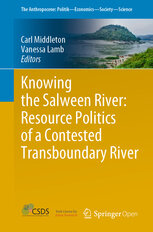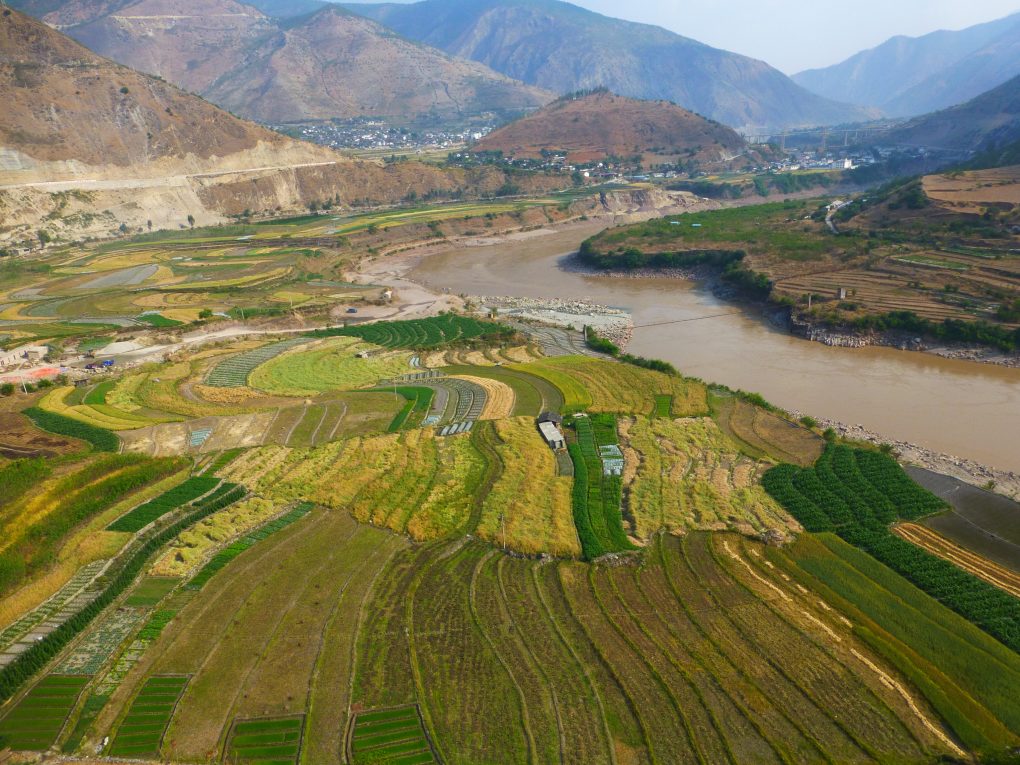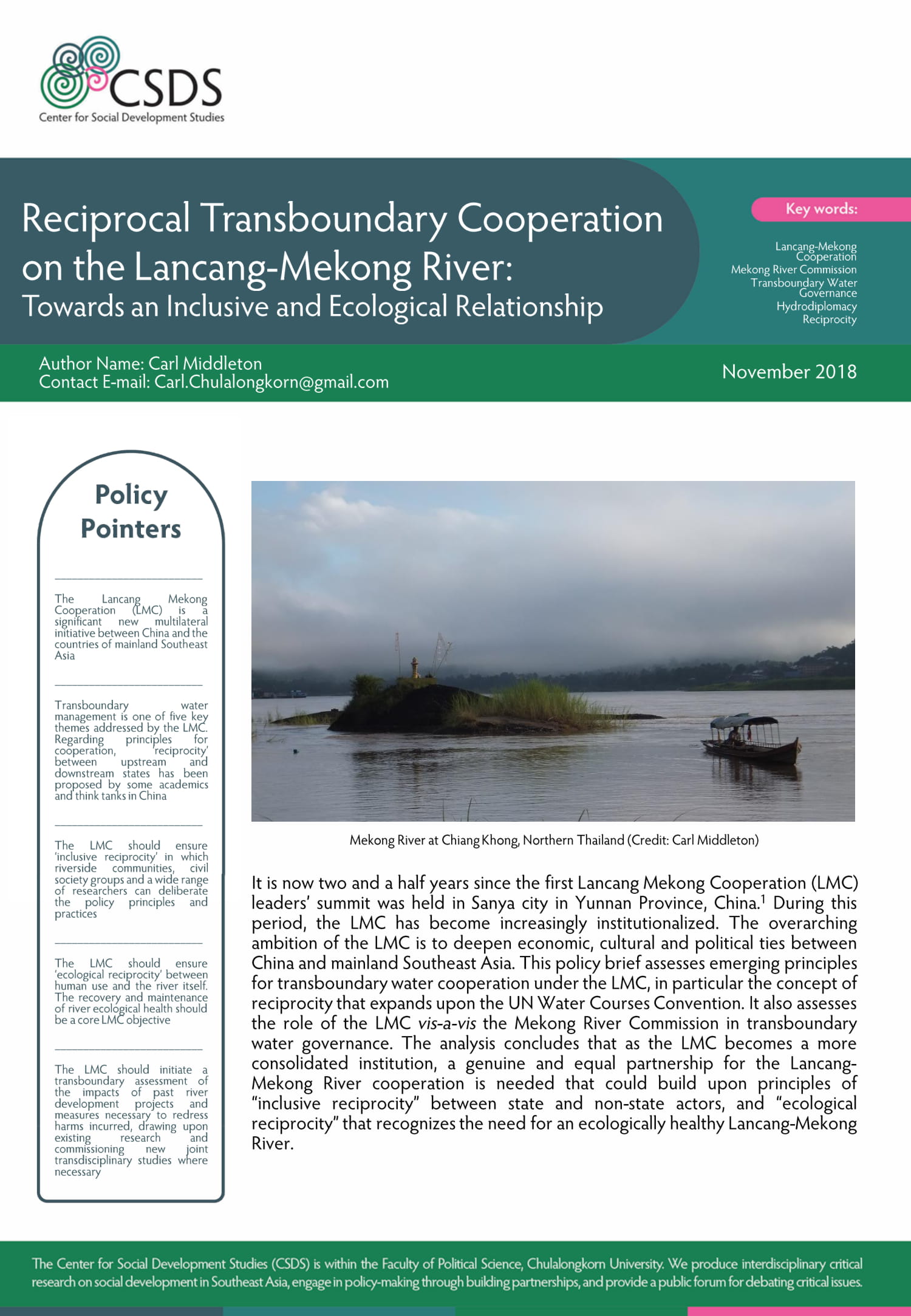ธรรมชาติเชิงวิพากษ์: โควิด – 19 เขตพรมแดนสุขภาพและความปราศจากมลทินของชาติไทย
/เขียนโดย อาจารย์ ดร.จิราพร เหล่าเจริญวงศ์*
(หมายเหตุ: บทความนี้เผยแพร่ครั้งแรกวันที่ 9 ตุลาคม 2563 ก่อนที่จะมีการระบาดระลอกใหม่)
[English version available here]
ภาพแสดงการตรวจวัดอุณหภูมิที่ชายแดนไทย-เมียนมา (เครดิต) THANT ZIN AUNG ชาวเมียนมา ที่ทำงานในประเทศไทย
แม้ว่าประเทศไทยจะเป็นประเทศแรกถัดจากจีนที่มีบันทึกการติดเชื้อโควิด-19 แต่ก็ประสบความสำเร็จในการควบคุมโรคนี้ในระยะเวลาไม่นาน เห็นได้ว่าจำนวนผู้ติดเชื้อสูงสุดที่พบอยู่ที่ประมาณ 100-150 รายต่อวันในเดือนมีนาคม 2563 แต่ก็ลดลงเหลือศูนย์ภายในเดือนพฤษภาคม และยังคงอยู่ที่ตัวเลขเดิมตั้งแต่นั้นมา โดยมีผู้ติดเชื้อรวมทั้งสิ้นประมาณ 3,500 รายและเสียชีวิต 59 รายนับตั้งแต่เริ่มการระบาด หลังจากนั้นสหภาพยุโรป (The European Union: EU) จึงประกาศให้ประเทศไทยไม่เป็นเขตอันตรายของการแพร่ระบาดอีกต่อไป ทำให้น่าประหลาดใจว่ารัฐไทยสามารถควบคุมหรือจัดการกับการแพร่ระบาดนี้ได้อย่างไร
บทความนี้ศึกษานโยบายเฉพาะกิจและกฎระเบียบที่รัฐบาลไทยใช้ในการควบคุมการแพร่ระบาดของโควิด-19 ภายในประเทศ จากการศึกษาวิจัยผ่านเอกสารและเก็บข้อมูลภาคสนามค้นพบว่า เพื่อควบคุมการแพร่กระจายของไวรัส (ทั้งจากภายนอกและภายในประเทศ) รัฐบาลไทยได้สร้าง 'พรมแดนสุขภาพ' เพื่อควบคุมการเคลื่อนย้ายของผู้คน รวมทั้งจัดตั้งหน่วยงานกำกับดูแลคือ ศูนย์บริหารสถานการณ์การแพร่ระบาดของโรคติดเชื้อไวรัสโคโรนา 2019 (โควิด – 19) ภายใต้พระราชกำหนดฉุกเฉิน สิ่งที่จำเป็นต้องใช้ในการผ่าน 'พรมแดนสุขภาพ' นี้ ได้แก่ ใบรับรอง Fit-to-Fly แบบฟอร์ม TM.08 หนังสือรับรองการตรวจสุขภาพที่ระบุผลการทดสอบโควิด-19 เป็นลบ และการกักกันตัวที่ดำเนินการโดยรัฐ 14 วัน สำหรับผู้ที่เดินทางกลับจากต่างประเทศ ขณะเดียวกันก็ออกกฎระเบียบสำหรับคนไทยที่อาศัยอยู่ในประเทศอันประกอบด้วย การปิดเมืองและห้ามการเคลื่อนย้ายระหว่างพื้นที่โดยต้องมีหนังสือรับรองการตรวจสุขภาพและการรับได้รับอนุญาตอย่างเป็นทางการในการเดินทางข้ามจังหวัด
น่าแปลกที่ในช่วงต้นของวิกฤติดังกล่าว รัฐบาลทั่วโลกเกือบทั้งหมดได้เรียกพลเมืองของตนกลับคืนสู่มาตุภูมิ แต่รัฐบาลไทยกลับปิดกั้นพลเมืองของตนไม่ให้กลับบ้านซึ่งทำให้นักเรียนไทยในต่างแดนจำนวนมากต้องติดอยู่ในประเทศระหว่างทางเป็นเวลาหลายวัน ต่อมารัฐบาลไทยจึงได้ประกาศ ‘เขตพรมแดนสุขภาพ’ และกำหนดให้คนไทยทุกคนต้องตรวจสุขภาพให้เรียบร้อยก่อนเดินทางกลับ (สำหรับคนที่ไม่แข็งแรงหรือเจ็บป่วยก็ไม่สามารถเดินทางกลับโดยเครื่องบินได้)
แทนที่จะมองและปฏิบัติต่อคนไทยในฐานะพลเมืองที่รัฐต้องปกป้อง แต่รัฐบาลไทยกลับแบ่งคนออกเป็น 2 กลุ่มคือ ผู้ติดเชื้อและผู้ที่มีร่างกายบริสุทธิ์ ผู้เขียนได้ออกแบบการวิเคราะห์ตามแนวคิดของดักลาสเรื่องความบริสุทธิ์และอันตราย (Douglas, 1966) การถือกำเนิดขึ้นของเขตชายแดนสุขภาพและกฎระเบียบไม่ใช่เพียงควบคุมการแพร่ระบาดของเชื้อไวรัสเท่านั้น แต่ยังชี้ให้เห็นความกังวลสูงสุดของรัฐบาลไทย คือ การทำให้ยอดผู้ติดเชื้อเป็นศูนย์รายและทำให้มันคงอยู่เช่นนั้นดังเช่นการรักษารัฐให้ปราศจากมลทิน ยิ่งไปกว่านั้นแรงงานไทยในต่างแดนที่เดินทางกลับจากต่างประเทศและแรงงานข้ามชาติถูกมองว่าเป็น ‘ร่างกายที่ปนเปื้อน’ ซึ่งถือว่าเป็นอันตรายและกลายมาเป็นเป้าหมายของการควบคุมและชำระให้บริสุทธิ์ผุดผ่อง พวกเขาต้องอยู่ในสถานที่กักกันของรัฐตามที่รัฐจัดหาให้โดยห้ามออกจากโรงแรมที่พักเป็นเวลา 14 วัน ก่อนจะได้รับอนุญาตให้กลับบ้านได้ สิ่งนี้เป็นเหมือนพิธีการเปลี่ยนผ่านที่ร่างกายต้องผ่านกระบวนการทำให้บริสุทธิ์เพื่อให้ได้รับการยอมรับกลับเข้ามาในสังคมไทยคล้ายกับแนวคิดเอานักโทษเข้าคุกโดยหวังจะเปลี่ยนคนเลวให้กลายเป็นคนดีได้ แต่ในช่วงที่ถูกกักกันคนเหล่านี้กลับไม่ได้รับการปฏิบัติอย่างเต็มที่ในฐานะประชาชนแต่คล้ายคลึงกับนักโทษเสียมากกว่า
เขตพรมแดนสุขภาพ: จุดตรวจวัดอุณหภูมิในเขตชายแดนแม่สอด (เครดิต) รวีพร ดอกใหม่
เขตพรมแดนสุขภาพ
การตอบสนองของรัฐบาลไทยที่มีต่อโควิด – 19 มีความคล้ายคลึงกับประเทศอื่นๆ ทั่วโลก รัฐ ชายแดนและบุคลากรผู้เชี่ยวชาญด้านสุขภาพ เป็นผู้เล่นที่มีบทบาทสำคัญยิ่งในช่วงวิกฤติที่คาบเกี่ยวกับความเป็นความตายของผู้คน ซึ่งนักวิชาการวิเคราะห์ว่าเป็น “รัฐยกเว้น” (Agamben, 2005) ในช่วงวิกฤติฉุกเฉินของโควิด – 19 ไม่มีอะไรสำคัญยิ่งกว่า ‘สุขภาพ’ หรือ ‘ระบบความปลอดภัยทางชีวภาพ’ ซึ่งนำไปสู่การเพิกถอนสิทธิและความเป็นส่วนตัวของพลเมืองได้ (Agamben, 2020) ในสภาวะยกเว้นเช่นนี้ อธิปไตย (รัฐ) มีอำนาจตัดสินใจว่าชีวิตของบุคคลใดควรค่าแก่การช่วยเอาไว้และชีวิตใดที่ไม่คุ้มค่า อย่างไรก็ตาม นโยบายการรับมือโควิด – 19 ที่มีผลต่อแรงงานไทยในต่างแดนและผู้อพยพจากประเทศเพื่อนบ้าน คือ การทำให้ขอบเขตของ "พลเมือง" และ "อื่นๆ" พร่าเลือนในนามของสุขภาพและความมั่นคงทางชีวภาพ ทุกคนได้รับการปฏิบัติด้วยในฐานะผู้ที่อาจจะเป็นอันตราย ไม่ว่าจะเป็นพลเมืองหรือไม่ใช่ ก็ล้วนแต่เป็นเพียงร่างกายที่อยู่ภายใต้สภาวะยกเว้นที่จำเป็นต้องผ่านด่านพรมแดนสุขภาพที่ตั้งขึ้นมาใหม่ (นอกเหนือจากพรมแดนทางภูมิศาสตร์และทางการเมืองที่มีอยู่แล้ว) เพื่อคัดกรองสุขภาพร่างกายก่อนเข้ามาในราชอาณาจักรไทย
ก่อนแพร่การระบาดของโควิด – 19 การเดินทางระหว่างประเทศจำเป็นต้องมีหนังสือเดินทางและวีซ่าที่ถูกต้องเพื่อข้ามพรมแดน บางประเทศขอให้คุณกรอกแบบฟอร์มเพื่อแจ้งว่าไม่ได้นำสินค้าหรืออาหารต้องห้ามเข้ามาในดินแดน แต่ในช่วงที่มีการระบาด รัฐไทยกำหนดให้คุณต้องชี้แจงเรื่องสุขภาพผ่านระบบ Fit to Fly แสดงผลการตรวจโรคโควิด – 19 ภายใน 72 ชั่วโมงล่วงหน้าและแบบฟอร์ม TM.08 หลังจากนั้นจะมีการบังคับกักกันตัว สิ่งต่างๆ เหล่านี้เปรียบเสมือนการข้ามพรมแดนสองครั้งโดยที่การข้ามพรมแดนสุขภาพมีความเข้มงวดยิ่งกว่าการข้ามพรมแดนโดยปกติ
ซึ่งแตกต่างจากสถานการณ์ทั่วไปในภูมิภาคเอเชียตะวันออกเฉียงใต้ที่พรมแดน (แผ่นดิน) มักมีรูพรุนและซึมผ่านได้ (van Schendel and de Maaker, 2014) โควิด – 19 ทำให้รัฐบาลไทยต้องปิดจุดตรวจคนเข้าเมืองหรือจุดอพยพทั้งหมดและผนึกพรมแดนของประเทศซึ่งมีความยาวประมาณ 5,656 กิโลเมตร ปรากฏการณ์นี้ไม่เคยเกิดขึ้นมาก่อน การปิดผนึกพรมแดนเป็นข้อกำหนดที่จำเป็นในการประกาศภาวะฉุกเฉินด้วยเหตุผลด้านสุขภาพโดยมีเป้าหมายเพื่อให้มีจำนวนผู้ติดเชื้อเป็นศูนย์
เอกสารประกอบเพื่อใช้ในการผ่านเข้าเขตพรมแดนสุขภาพของคนไทยประกอบด้วย
ใบรับรองการเดินทาง Fit to Fly หรือ Fit to Travel ซึ่งออกใบรับรองโดยแพทย์
ผลการตรวจสุขภาพที่ระบุผลทดสอบโควิด – 19 เป็นลบ
แบบฟอร์ม TM.08 แบบคำขออนุญาตกลับเข้ามาในราชอาณาจักรไทย
แบบฟอร์มการแจ้งรับบริการเพื่อการกักกันโดยรัฐ จำนวน 14 วัน
ในการเดินทางกลับประเทศไทย ผู้เดินทางชาวไทยที่อาศัยอยู่ในต่างประเทศจะต้องติดต่อกับสถานทูตไทยในประเทศที่ตนพำนักอยู่ พวกเขาจำเป็นต้องปฏิบัติตามขั้นตอนและกรอกรายละเอียดลงในเอกสารทั้งหมด ทุกคนจะต้องดำเนินการต่างๆ ผ่านสถานทูตไทยในพื้นที่เท่านั้น ได้แก่ การจัดการเที่ยวบิน (ส่งตัวกลับ) ซึ่งไม่สามารถจองเที่ยวบินเองได้ เมื่อกลับมาถึงคุณจะถูกส่งตัวไปยังโรงแรมที่จัดเตรียมไว้ซึ่งคุณจะต้องอยู่ที่นั่นต่อไปอีก 14 วัน อย่างไรก็ตามแรงงานไทยที่อาศัยอยู่ในต่างแดนไม่ได้มีลักษณะเดียวกันทุกคน พวกเขาอาจจะเป็นนักเรียน ข้าราชการพลเรือน นักท่องเที่ยว หุ้นส่วนชาวต่างชาติ แรงงานข้ามชาติ (ไม่มีเอกสาร) ไม่ใช่ทุกคนที่จะได้รับเอกสารเหล่านี้ เนื่องจากขั้นตอนที่ยุ่งยาก การขาดเอกสารทางกฎหมายหรือมีปัญหาอื่นๆ ที่เกิดขึ้นในช่วงระหว่างการดำเนินการ
แรงงานไทยที่เดินทางมาจากประเทศมาเลเซียชี้แจงว่าเป็นเรื่องยากยิ่งที่จะได้รับการรับรอง Fit-to-Travel (สำหรับการเดินทางทางบก) โดยเฉพาะอย่างยิ่งผู้ที่ไม่สามารถพูดภาษามาเลย์หรือภาษาอังกฤษได้ บางคนระบุว่าเพื่อที่จะได้รับเอกสารเหล่านี้พวกเขาจำเป็นต้องเดินทางจากที่ทำงานซึ่งอยู่ใกล้กับชายแดนไทยไปยังกัวลาลัมเปอร์ เมืองหลวงของมาเลเซีย ซึ่งทำให้เสียทั้งเงินทองและเวลามาก หลายคนตัดสินใจข้ามพรมแดนกลับประเทศไทยอย่างผิดกฎหมาย ยิ่งไปกว่านั้นชายแดนได้ถูกปิดผนึกและรัฐบาลไทยอนุญาตให้ส่งกลับได้เพียง 100 คนต่อวัน บางรายต้องรอเวลาเพื่อเดินทางกลับประเทศไทยนานกว่าหนึ่งสัปดาห์ ในเขตพรมแดนสุขภาพ ความเป็นพลเมืองแทบจะไม่มีน้ำหนักอะไรเลย ทุกอย่างเป็นเรื่องของความปลอดภัยทางชีวภาพและจำนวนผู้ติดเชื้อเป็นศูนย์เท่านั้น ฟาสซินเน้นย้ำว่านี่คือ “หลักการของพลังชีวภาพในการทำให้ชีวิตกลายเป็นเรื่องของการเลือกว่าใครที่ควรจะมีชีวิตอยู่ มีชีวิตแบบไหนและยาวนานแค่ไหน” นอกจากนี้ ชีวิตภายใต้อำนาจทางชีวภาพยังไม่เท่าเทียมกัน (Fassin,2009: 53) กรณีของแรงงานข้ามชาติไทยจากมาเลเซียแสดงให้เห็นอย่างชัดเจนว่าภายใต้เขตพรมแดนสุขภาพนี้การกลับมาของพวกเขาถูกยืดระยะเวลาออกไปโดยรัฐไทย ซึ่งชีวิตของพวกเขาอาจจะไม่สำคัญนักในขณะที่ร่างกายอยู่ภายใต้การบงการผ่านการเรียกร้องให้เสียสละเพื่อควบคุมไวรัสภายในประเทศ
ความบริสุทธิ์ผุดผ่องของร่างกาย (ชาติ) ไทย
นายแพทย์ ทวีศิลป์ วิษณุโยธิน กล่าวสรุปสถานการณ์โควิด – 19 ที่ศูนย์บริหารสถานการณ์โควิด – 19 (CCSA) ทำเนียบรัฐบาลแห่งประเทศไทย วันที่ 2 เมษายน 2563 (เครดิต) สถานีวิทยุโทรทัศน์แห่งประเทศไทย
“ตั้งแต่วันที่ 3 พฤษภาคม จำนวนผู้ป่วยโควิด – 19 รายใหม่ที่รายงานทุกวันเป็นตัวเลขเดียวยกเว้น 18 รายที่พบในกลุ่มผู้อพยพที่ถูกกักกันในจังหวัดสงขลา เมื่อวันที่ 4 พฤษภาคม”
กล่าวโดย ดร.ทวีศิลป์ วิษณุโยธิน [1]
ข้อความดังกล่าวแสดงให้เห็นอย่างชัดเจนว่าประเทศไทยปลอดโควิด – 19 เป็นครั้งแรก[2] และร่างกายของชาติไทยได้รับการชำระล้างหรือทำให้บริสุทธิ์ผุดผ่อง ข้อยกเว้นในคำพูดบ่งบอกว่า แรงงานข้ามชาติที่เดินทางกลับมาจากมาเลเซียและอยู่ในเขตกักกันของรัฐไม่ได้รับการพิจารณาว่าเป็นส่วนหนึ่งของ 'ร่างกายของชาติไทย' และไม่นับว่าเป็นคนไทยเนื่องจากพวกเขาเป็นผู้อพยพซึ่งมีร่างกายเป็นที่ต้องสงสัยและมีโอกาสที่จะติดเชื้อ ซึ่งสิ่งนี้อาจจะทำให้ร่างกายที่บริสุทธิ์ของชาติไทยต้องแปดเปื้อน
ดร.ทวีศิลป์ กล่าวเพิ่มเติมว่า
"เราสามารถผ่อนคลายได้แต่ประมาทไม่ได้ ... โปรดปฏิบัติตามแนวทางปฏิบัติใหม่ๆ ในที่สุดเราอาจเป็นหนึ่งในประเทศแรกๆ ที่สามารถยุติความยากลำบากที่เกิดจากโรคนี้ได้"
คำพูดนี้แสดงให้เห็นว่าสิ่งที่รัฐไทยต้องการคือ การได้รับความเชื่อถือและยอมรับจากประชาคมโลกว่าสามารถจัดการกับโรคนี้ได้และเป็นหนึ่งในประเทศที่ปลอดโควิด แต่เพื่อให้ประเทศปราศจากจากโควิด – 19 (ซึ่งที่จริงแทบเป็นไปไม่ได้เลยที่จะทำให้เป็นเช่นนั้น) จำเป็นต้องเสียสละหลายสิ่ง นอกเหนือจากการเสียสละของเจ้าหน้าที่ทางการแพทย์ที่ทำงานอย่างหนักแล้ว คือการกำหนดมาตรการล็อกดาวน์บังคับให้ผู้คนต้องอยู่บ้านซึ่งนำไปสู่การสูญเสียงานในภาคส่วนที่คนต้องออกไปทำงานนอกบ้าน ผู้คนไม่สามารถเลี้ยงดูครอบครัวของตนเองได้และสิ้นหวังเพราะเงินออมเหลือน้อยลงทุกทีอีกทั้งมีหนี้สินต้องจ่าย กรมสุขภาพจิตรายงานว่า มีคนไทยฆ่าตัวตายในช่วงต้นปี จำนวน 2551 คน อัตราดังกล่าวเพิ่มขึ้น 22 เปอร์เซ็นต์เมื่อเทียบกับปีที่แล้ว ผลการศึกษาวิจัยจากทีมนักวิชาการไทยเปิดเผยว่ามี 38 กรณีที่มีผู้ให้สัมภาษณ์ว่าพยายามฆ่าตัวตายจากสาเหตุการปิดประเทศ การปิดกิจการ การตกงาน และการเลิกจ้าง และใน 38 รายนี้ มี 28 ราย ที่เสียชีวิต[3]
ความคิดเรื่อง "ร่างกายที่บริสุทธิ์" ของชาติยังส่งผลให้เกิดความเกลียดกลัวชาวต่างชาติและการเหยียดเชื้อชาติในกรณีของแรงงานไทยที่เดินทางกลับจากประเทศเกาหลีใต้ แรงงานไทยเหล่านี้ถูกเรียกอย่างไม่เป็นทางการว่า ‘ผีน้อย’ เนื่องจากพวกเขาพำนักและทำงานในเกาหลีใต้อย่างผิดกฎหมาย และเป็นกลุ่มแรกๆ ที่เดินทางกลับมายังประเทศไทย ทำให้เกิดประเด็นถกเถียงกันอย่างดุเดือดในสังคมไทย เมื่อสื่อสังคมออนไลน์เปิดเผยให้เห็นว่าแรงงานข้ามชาติหญิงรายหนึ่งไม่ได้กักกันตนเองเมื่อเดินทางมาถึงบ้านเกิดใน จ.เชียงราย เธอได้แวะไปร้านอาหารและซื้อของ จากกรณีของเธอสังคมไทยเริ่มชี้เป้าและตำหนิว่าแรงงานข้ามชาติที่กลับมานั้นขาดความรับผิดชอบต่อสังคมไทย (และพวกเขายังขาดความรับผิดชอบที่ไปอยู่ในประเทศเกาหลีใต้แบบผิดกฎหมายจนส่งผลกระทบต่อนักท่องเที่ยวชาวไทยคนอื่นๆ อีกด้วย) และพวกเขาเป็นผู้แพร่กระจายเชื้อ แม้ว่าพวกเขาจะได้รับการปฏิบัติที่ค่อนข้างแย่จากรัฐบาลไทยก็ตาม แต่ในภายหลังปรากฏว่าผู้ที่ทำให้เกิดการแพร่ระบาดของไวรัสครั้งใหญ่ในประเทศไทยไม่ได้มาจากคนกลุ่มนี้แต่กลับกลายเป็นกลุ่มคนชั้นกลางระดับสูงและคนที่มีชื่อเสียงของไทยที่เข้าไปชมการชกมวยในสนามมวยมากกว่า
ยิ่งไปกว่านั้นความคิดเรื่องความบริสุทธิ์ผุดผ่องยังแทรกซึมลงไปในระดับจังหวัดและจิตใจของแต่ละบุคคล ตรัง เป็นหนึ่งในไม่กี่จังหวัดที่ปลอดโควิด – 19 ตามรายงานของศูนย์อำนวยการแก้ไขสถานการณ์ฉุกเฉิน เพื่อนของผู้เขียนซึ่งเป็นนักเรียนไทยในต่างแดนที่เดินทางกลับจากสหราชอาณาจักรก่อนที่รัฐบาลไทยจะประกาศปิดพรมแดนได้ทำการกักกันตนเองเป็นเวลา 14 วัน ภายในบ้านที่ จ.ตรัง ระหว่างที่รอเขาบอกผู้เขียนว่าเขากังวลว่าอาจจะติดเชื้อแล้วแพร่โรคนี้ไปยังพ่อแม่ของเขา แต่สิ่งที่ทำให้กังวลมากขึ้นอีกคือ เขาอาจจะเป็นผู้ติดเชื้อรายแรกในจังหวัดตรัง ชื่อของเขาจะถูกประกาศและสร้างความอับอาย เราไม่ต้องการเป็นตัวอันตรายที่จะนำความไม่บริสุทธิ์มาสู่แผ่นดิน ในทำนองเดียวกันสิ่งนี้สะท้อนให้เห็นว่ารัฐบาลไทยมีแนวความคิดอย่างไรเมื่อต้องจัดการกับโควิด – 19 อันเชื่อมโยงกับ ‘ความบริสุทธิ์ของร่างกายชาติไทย’
จุดตรวจวัดอุณหภูมิชายแดนแม่สอด (ฝั่งไทย) (เครดิต) รวีพร ดอกใหม่
ผู้ย้ายถิ่น ผู้เดินทางกลับ การเมืองร่างกายและสิทธิเสรีภาพ
ในช่วงเวลาที่ไม่แน่นอนของโควิด – 19 ร่างกายของคนไทยในต่างแดนและแรงงานข้ามชาติ ถูกพิจารณาว่าเป็นอันตรายเหมือนกันหมดทั้งสิ้น ไม่ว่าจะเป็นคนสัญชาติใด เป็นคนไทยหรือไม่ใช่ก็ตาม พวกเขาจะต้องถูกกักกันก่อนจึงจะสามารถกลับไปใช้ชีวิตในสังคมได้ แม้ว่าร่างกายของพวกเขาจะอยู่ในประเทศไทยแต่พวกเขาจะถูกกีดกันไม่ให้สามารถเข้าถึงสิทธิอย่างเต็มที่ในฐานะพลเมืองไทย โควิด – 19 ส่งผลกระทบต่อร่างกายของคนไทยและแรงงานข้ามชาติอื่นๆ ในรูปแบบที่แตกต่างและคล้ายคลึงกันดังที่ผู้เขียนชี้แจงไว้ต่อไปนี้
i. ร่างกายของผู้ต้องสงสัยและพิธีกรรมทางเดิน
ดังที่ผู้เขียนได้อธิบายไว้ข้างต้น ผู้อพยพชาวไทยในต่างแดนจำเป็นต้องส่งเอกสารจำนวนมากก่อนที่จะเดินทางกลับประเทศไทย เมื่อเดินทางมาถึงแล้วทุกคนจะต้องอยู่ในสถานที่กักกันของรัฐเป็นระยะเวลา 14 วัน ร่างกายของพวกเขาถือว่าเป็นอันตรายเนื่องจากอาจมีเชื้อไวรัสดังกล่าว ดังนั้นจึงต้องอยู่ในที่ห่างไกลจากผู้คน สิ่งนี้เปรียบเสมือนพิธีกรรมที่พวกเขาอยู่ในสภาวะกำกวม (liminal stage) และจะได้รับการยอมรับกลับคืนสู่สังคมหลังจากที่ร่างกายของพวกเขาได้รับการยืนยันว่าปราศจากไวรัส ยิ่งไปกว่านั้น กฎระเบียบดังกล่าวยังทำให้เกิดเส้นบางๆ ระหว่างการเป็นพลเมืองและการเป็นผู้อพยพ (อื่นๆ) โดยลดสถานะให้เป็นผู้ต้องสงสัย
กล่าวอีกนัยหนึ่งก็คือ โควิด – 19 ได้ยกเลิกสิทธิของพลเมืองชั่วคราวที่จะมีชีวิตที่เปลือยเปล่า (Bare Life) (Agamben, 2005) การติดป้ายลงไปว่ามาจากต่างประเทศคือร่างกายที่อันตราย ร่างกายที่เปลือยเปล่าไม่ว่าจะเป็นคนไทยหรือคนย้ายถิ่นกลายเป็นภัยต่อความมั่นคงด้านสุขภาพของคนทั้งสังคม นี่คือวิธีการดำเนินการของรัฐยกเว้น
อย่างไรก็ตาม ร่างกายของแรงงานข้ามชาติชาวพม่าซึ่งก็ถือว่าเป็นอันตรายยังคงมีพลังอำนาจบางอย่างอยู่ จากงานของดักลาส (1966) การที่ร่างกายอยู่สภาวะกำกวม เช่น ทารกในครรภ์ของผู้หญิงนั้นมีอำนาจแม้ว่าจะยังไม่เป็นมนุษย์ก็เพราะอาจทำให้ผู้ที่อุ้มท้องเสียชีวิตได้ กรณีร่างกายของผู้ย้ายถิ่นพวกเขาอาจมีหรือไม่มีไวรัสอยู่ จึงทำให้สถานะของพวกเขาไม่ชัดเจน ดั้งนั้นร่างกายของพวกเขาจึงเป็นอันตรายต่อประเทศไทยเนื่องจากอาจแพร่เชื้อไวรัสไปสู่คนไทยในประเทศได้ ในประเทศสิงคโปร์ ชุมชนแรงงานข้ามชาติถูกลืมโดยรัฐบาลและส่งผลให้เกิดการแพร่กระจายของไวรัสในวงกว้าง สิ่งนี้สร้างความกังวลให้แก่รัฐบาลไทยเนื่องจากต้องการให้ประเทศไทยพ้นจากการระบาดระลอกสอง ดังนั้น ในขณะที่แรงงานข้ามชาติเป็นมลทินและกลายเป็นเรื่องที่ต้องควบคุมแต่พวกเขาก็ได้รับการดูแลรักษาพยาบาลเช่นเดียวกับคนไทยในระยะเวลาสั้นๆ เนื่องจากพวกเขามีอันตราย (และอันตรายนี้เป็นอำนาจในตัว) ขณะเดียวกันแรงงานไทยในต่างแดนก็มีความรู้สึกว่าตนถูกลดทอนความเป็นพลเมืองเมื่อข้ามพรมแดนสุขภาพ โควิด – 19 และรัฐบาลไทยได้ทำให้พวกเขาผ่านช่วงเวลาสั้นๆ ของความกำกวมซึ่งเป็นประสบการณ์เดียวกันกับที่แรงงานข้ามชาติจากประเทศเพื่อนบ้านได้เผชิญ
ii. ช่วงเวลาจำกัดสองเท่า
ในช่วงกลางเดือนมีนาคม รัฐบาลไทยได้ประกาศล็อกดาวน์และปิดกั้นพรมแดน เป็นเวลาเดียวกับที่จำนวนผู้ติดเชื้อพุ่งสูงขึ้น ซึ่งเป็นจังหวะเดียวกับที่แรงงานข้ามชาติจำนวนมากจากประเทศเมียนมาถึงเวลาต่ออายุหรือขยายใบอนุญาตทำงานพอดี กระบวนการนี้ไม่สามารถทำได้ในกรุงเทพฯ แต่ละคนจำเป็นต้องกลับเดินทางกลับเมียนมา พวกเขาจึงมักผนวกเอาการต่ออายุใบอนุญาตทำงานเข้ากับวันหยุดสงกรานต์เพื่อจะได้ใช้เวลาในบ้านเกิดอย่างคุ้มค่า อย่างไรก็ตาม เนื่องจากการปิดประเทศทำให้หลายคนตกงาน แม้แต่กลุ่มที่ (ยัง) ไม่ถูกเลิกจ้างก็มีความวิตกกังวลกับอนาคตที่ไม่แน่นอนนี้และวันหนึ่งในไม่ช้าพวกเขาอาจจะถูกให้ออกจากงานเช่นกัน ทำให้พวกเขาเกิดความกังวลว่าควรจะกลับบ้านที่เมียนมาหรือว่ารอให้สถานการณ์ดีขึ้นแล้วจึงต่อวีซ่าหรือว่าควรจะอาศัยอยู่ในประเทศไทยต่อไป
ในกลุ่มที่ตัดสินใจเดินทางกลับ หลายคนต้องติดอยู่ที่ชายแดนไทย-เมียนมา เนื่องจากพรมแดนถูกปิดต้องใช้เวลาหลายวันก่อนที่รัฐบาลไทยและเมียนมาจะมีข้อตกลงเปิดพรมแดนชั่วคราวให้กลุ่มแรงงานข้ามชาติเหล่านี้เดินทางกลับได้ ในเวลานั้นรัฐบาลเมียนมากีดกันพลเมืองของตัวเองที่จะกลับบ้านเช่นเดียวกับประเทศไทย กลุ่มผู้ถูกส่งกลับจำเป็นต้องกักกันตัวเองเป็นเวลา 16 วัน ตามที่รัฐบาลเมียนมาสั่ง ต่อมาผู้เดินทางกลับบางส่วนต้องการกลับมาที่ฝั่งไทยเมื่อทราบข่าวจากเพื่อนฝูงของตนเองว่าโรงงานในไทยได้เปิดทำการอีกครั้งหลังจากปิดไป 3 เดือน แต่พรมแดนก็ยังคงปิดไม่ให้มนุษย์ข้ามได้ ยกเว้นการเปิดพรมแดนเพื่อการซื้อขายสินค้าเท่านั้น พวกเขาหลายคนตัดสินใจเดินทางกลับโดยข้ามพรมแดนอย่างผิดกฎหมายซึ่งบางส่วนถูกตำรวจชายแดนไทยจับตัวและส่งกลับไปยังฝั่งเมียนมา
นอกจากนี้ ยังมีช่วงเวลาที่รัฐบาลท้องถิ่นมีความยืดหยุ่นในการเปิดพรมแดนให้ผู้อพยพข้ามกลับได้ แต่พวกเขาก็ยังจำเป็นต้องมีเอกสารแสดงตัวตนทั้งหมดตามที่ผู้เขียนได้กล่าวไว้ข้างต้นเพื่อผ่านพรมแดนสุขภาพ ที่ชายแดนฝั่งไทย เจ้าหน้าที่ได้ตรวจสอบอุณหภูมิร่างกายของผู้อพยพ มีกรณีที่ผู้อพยพชาวไทใหญ่ผ่านด่านตรวจคนเข้าเมืองจากฝั่งเมียนมาแล้วจะเข้ามายังฝั่งไทยแต่อุณหภูมิร่างกายสูงเกิน 37.5 องศาเซลเซียส เจ้าหน้าที่ไทยจึงได้ส่งตัวเขากลับแต่รัฐบาลเมียนมาไม่ให้เขากลับเข้าประเทศ นักเคลื่อนไหวท้องถิ่นใน อ.แม่สอด รายงานว่ามีอีกกรณีหนึ่งที่แรงงานหญิงชาวมุสลิมกลับไปเมียนมาในช่วงแรกของการปิดพรมแดน พวกเธอสามารถกลับเข้าเมียนมาได้ แต่รัฐบาลเมียนมาได้กักกันพวกเธอไว้ที่ชายแดนเป็นเวลา 16 วัน เมื่อไปถึงบ้านชาวบ้านต่างไม่พอใจเพราะกลัวว่าพวกเธออาจแพร่เชื้อไวรัสไปยังพวกเขารวมถึงสมาชิกในครอบครัว จึงต้องอยู่ในบ้านเพิ่มอีก 14 วัน ต่อมาเมื่อกลับมาที่ฝั่งไทย ชุมชนแรงงานข้ามชาติใน อ.แม่สอด ก็เรียกร้องให้กักกันตนเองอีก 14 วัน เธอได้รับอาหารจากพี่สาวที่มาเยี่ยมเธอวันละสองครั้ง สิ่งนี้แสดงให้เห็นอย่างชัดเจนว่าในช่วงการระบาดของโควิด – 19 และระยะผ่อนคลาย แรงงานข้ามชาติที่อยู่ในสถานะจำกัดอยู่แล้วจะต้องตกอยู่ในเงื่อนไขอื่นๆ ด้วย ซึ่งไม่แน่ใจว่าสิ่งเหล่านี้จะสิ้นสุดเมื่อใด ชีวิตของพวกเขาเหมือนจำกัดอยู่ระหว่างเขตแดนสองชั้น ชั้นแรกมาจากสถานะของพวกเขาในสังคมไทย และโควิด – 19 ก็มาสร้างความจำกัดอีกชั้นให้กับพวกเขา
iii. ความยากลำบากที่เพิ่มขึ้น
มีแรงงานข้ามชาติอีกกลุ่มหนึ่งที่ตัดสินใจไม่กลับเนื่องจากยังไม่ถูกยกเลิกการจ้างงานหรือนายจ้างไม่อนุญาตให้กลับ กลุ่มนี้อาจไม่ต้องเผชิญกับความจำกัดสองชั้นหรือหลายชั้นแต่กลับต้องรับมือกับความยากลำบากในชีวิตประจำวันขณะที่อยู่ในช่วงเวลานี้
ตี๋ตี๋ ทำงานเป็นแม่บ้านอยู่ชานเมืองกรุงเทพฯ เธอกล่าวว่าแม้ว่าโควิด – 19 จะไม่ได้ทำให้เธอตกงานแต่ในระหว่างที่ปิดประเทศ เธอจะต้องเพิ่มชั่วโมงการทำงาน เนื่องจากสมาชิกในครอบครัวของนายจ้างอยู่กับบ้านในช่วงระหว่างการล็อกดาวน์ นอกเหนือจากหน้าที่ประจำแล้ว พวกเขายังเรียกร้องการบริการเพิ่มขึ้น ดังนั้น เธอจึงมีเวลาพักผ่อนน้อยลง เธอกล่าวว่าสิ่งเหล่านี้พอรับได้และดีกว่าที่จะต้องตกงานในช่วงวิกฤติแบบนี้ เช่นเดียวกับกรณีของ ตู โม ที่ทำงานเป็นผู้ช่วยในร้านค้าใจกลางกรุงเทพฯ เธอไม่สามารถกลับไปประเทศเมียนมาได้เพราะนายจ้างไม่ต้องการแบกรับความเสี่ยงที่เธออาจไม่สามารถเดินทางกลับเข้ามาในประเทศไทยได้อีก เธอเล่าให้ฟังว่าคิดถึงครอบครัวโดยเฉพาะลูกชายวัย 2 ขวบ ที่พากลับประเทศเมียนมาเมื่อปีที่แล้วและขอให้พ่อแม่ช่วยดูแลเขา เธอตั้งตารอจะได้เห็นและกอดเขาอีกครั้งในช่วงติงจัน (Thingyan) ซึ่งเป็นเทศกาลปีใหม่ของเมียนมาแต่มันเป็นไปไม่ได้เพราะการระบาดของโรคโควิด – 19 สำหรับเธอแล้วติงจันไม่ได้เป็นแค่วันหยุดเท่านั้นแต่ยังเป็นช่วงเวลาอันมีค่าที่ได้อยู่บ้านพักผ่อนพบปะเพื่อนฝูงและญาติๆ เข้าร่วมในพิธีทางศาสนารวมถึงการจัดการธุระทางราชการ เช่น การต่ออายุใบอนุญาตทำงาน
วิน หนุ่มชาวลาหู่-พม่า ทำงานในฟาร์มกล้วยไม้ จ.นครปฐม เล่าให้ผู้เขียนฟังว่าก่อนเกิดการระบาดของโรคโควิด – 19 เขาและเพื่อนร่วมงานต้องทำงานทุกวัน แต่ในระหว่างการปิดประเทศ คำสั่งซื้อจากต่างประเทศได้หยุดชะงักลง นายจ้างของเขาเลิกเพาะปลูกกล้วยไม้และเลิกจ้างพนักงานครึ่งหนึ่ง ตัวเขาไม่ถูกเลิกจ้างเนื่องจากทำงานกับนายจ้างคนนี้มาเกือบ 8 ปี แต่เขาไม่ได้เงินเดือน นายจ้างอนุญาตให้เขาอยู่ในบ้านพักคนงานได้ เขาหยุดส่งเงินกลับบ้านเป็นเวลานานกว่าสามเดือน ภรรยาโทรมาถามว่าจะส่งเงินให้เธอได้เมื่อไรเพราะลูกๆ ต้องกินและใช้จ่ายทุกวัน เขาต้องการงานพาร์ตไทม์เพื่อหารายได้แต่มันเป็นไปไม่ได้เลยในช่วงเวลานี้ ทำให้เขาเครียดและสิ้นหวัง
นาฬิกาแสดงเขตเวลาในสำนักงานศุลกากรของชายแดนไทย-เมียนมา อ.ท่าขี้เหล็ก ประเทศเมียนมา และ อ.แม่สอด ประเทศไทย (เครดิตภาพถ่าย) Uwe Aranas
บทสรุป
ดังที่เรารู้กันดีว่าการระบาดของ COVID-19 ส่งผลกระทบต่อร่างกายของผู้อพยพในรูปแบบที่แตกต่างและคล้ายคลึงกันกับคนไทย สำหรับแรงงานข้ามชาติชาวพม่า ร่างกายของพวกเขามีความจำเป็นต่อเศรษฐกิจไทยในฐานะแรงงาน ไม่ใช่เพื่ออย่างอื่น ในแง่หนึ่งมันเป็นร่างกายที่ใช้แล้วทิ้ง เพราะเมื่อพวกเขากลับไป แรงงานอพยพคนอื่นก็สามารถเข้ามาแทนที่เขาหรือเธอได้ ในแง่นี้พวกเขาจึงเป็น 'อื่น' ที่เป็นแก่นสารสำหรับรัฐไทย (และพลเมืองจำนวนมากที่จ้างแรงงานข้ามชาติเหล่านี้)
ในขณะที่โควิด -19 ให้ความสำคัญกับ 'ร่างกาย' รุนแรงขึ้น โดยการกำหนดสถานะของการยกเว้นและการสร้างพรมแดนด้านสุขภาพที่เข้มงวดนอกเหนือจากพรมแดนปกติ (ทางการด้านเมืองหรือภูมิศาสตร์) การที่พลเมืองไทยกลับมาค้นพบว่าตัวพวกเขาเองถูกควบคุมในรูปแบบลักษณะเดียวกัน เนื่องจากร่างกายของพวกเขาในฐานะที่เป็นพาหะของไวรัสอยู่ภายใต้ระบบการปกครองด้านสุขภาพเดียวกันซึ่งกำหนดให้ทุกคนไม่ว่าจะเป็นพลเมืองหรือไม่ใช่พลเมืองต้องได้รับการตรวจสอบและเข้าสู่ช่วงกำกวม ก่อนที่จะได้รับการยอมรับกลับเข้าสู่สังคมไทย ผู้เขียนชี้แจงให้เห็นในบทความนี้แล้วว่าเป้าหมายสูงสุดของสังคมไทยคือ การทำให้สังคมบริสุทธิ์ การชำระล้างเชื้อไวรัสทั้งหมด แม้กระทั่งการได้รับการยอมรับจากนานาชาติสำหรับการรับมือที่ประสบความสำเร็จ แต่ไม่ได้คำนึงถึงพลเมืองของตนเองที่หลงเหลืออยู่ในต่างประเทศ เศรษฐกิจที่ตกต่ำ คนตกงานและการฆ่าตัวตายเพิ่มขึ้นในระดับประเทศ
แม้ว่าตลอดหลายเดือนที่ผ่านมาจะมียอดผู้ป่วยรายใหม่เป็นศูนย์ แต่จากการสำรวจชี้ให้เห็นถึงการสนับสนุนอย่างเป็นวงกว้างในหมู่ประชาชนเพื่อให้ใช้ พรก.ฉุกเฉิน และรักษาจำนวนผู้ติดเชื้อรายใหม่เป็นศูนย์จากมูลค่าความเสียหายทั้งหมด ซึ่งแสดงให้เห็นว่าวาทกรรมเรื่องความบริสุทธิ์ของชาติไทยดำเนินไปอย่างลึกซึ้งและแพร่หลาย (ไม่เพียงแค่ในรัฐบาล) แม้ว่าหน่วยงานด้านสุขภาพของไทยจะมีความพร้อมในการรับมือกับผู้ป่วยในระดับหนึ่ง (ซึ่งอาจมีหากรัฐผ่อนปรนมาตรการและกฎระเบียบต่างๆ มากกว่านี้) แต่ก็ยังไม่มีความชัดเจนว่าจะยกเลิกภาวะฉุกเฉินลงเมื่อใด
———
* คณะกรรมการ ศูนย์เชี่ยวชาญเฉพาะทางด้านการเมืองทรัพยากรเพื่อการพัฒนาสังคม ศูนย์ศึกษาการพัฒนาสังคม คณะรัฐศาสตร์จุฬาลงกรณ์มหาวิทยาลัย
[1] ดร.ทวีศิลป์ วิษณุโยธิน โฆษกประจำศูนย์อำนวยการแก้ไขสถานการณ์ฉุกเฉิน โควิด – 19 อ้างจากหนังสือพิมพ์บางกอกโพสต์ (13 พฤษภาคม 2020) ไม่มีการเรียกข้อมูลผู้ติดเชื้อราย ใหม่จากครั้งแรกโดย https://www.bangkokpost.com/thailand/general/1917380/no-new-covid-cases-for-the-first-time (เข้าถึงครั้งสุดท้ายวันที่ 1 ตุลาคม 2563)
[2] ในประเทศไทยทุกคนที่ได้รับการวินิจฉัยว่าติดเชื้อโควิด – 19 จะถูกส่งตัวไปโรงพยาบาลและถูกกักบริเวณ
[3] อรรถจักร์ สัตยานุรักษ์ และคณะ (2020) โครงการวิจัย คนจนเมืองที่เปลี่ยนไปในสังคมเมืองที่กำลังเปลี่ยนแปลง สนับสนุนโดย สำนักงานคณะกรรมการส่งเสริมวิทยาศาสตร์ วิจัยและนวัตกรรม (สกสว.)


















![OPINION: Reasons for Water Scarcity in Hakha [In Chin language]](https://images.squarespace-cdn.com/content/v1/575fb39762cd94c2d69dc556/1504755838131-9A2VYSXYJTH3J975T5MF/Carl3.jpg)